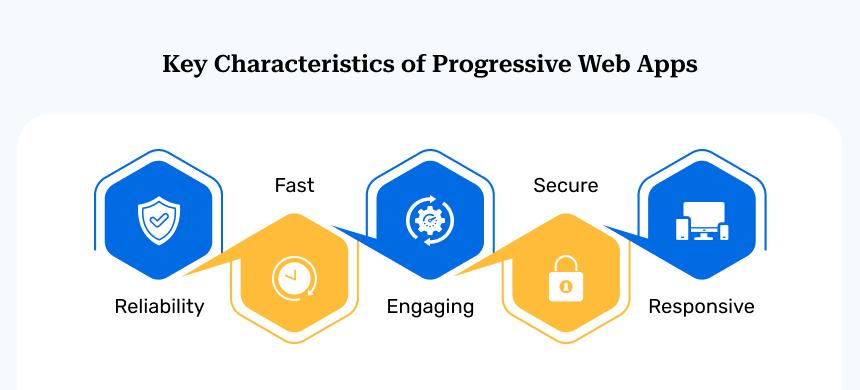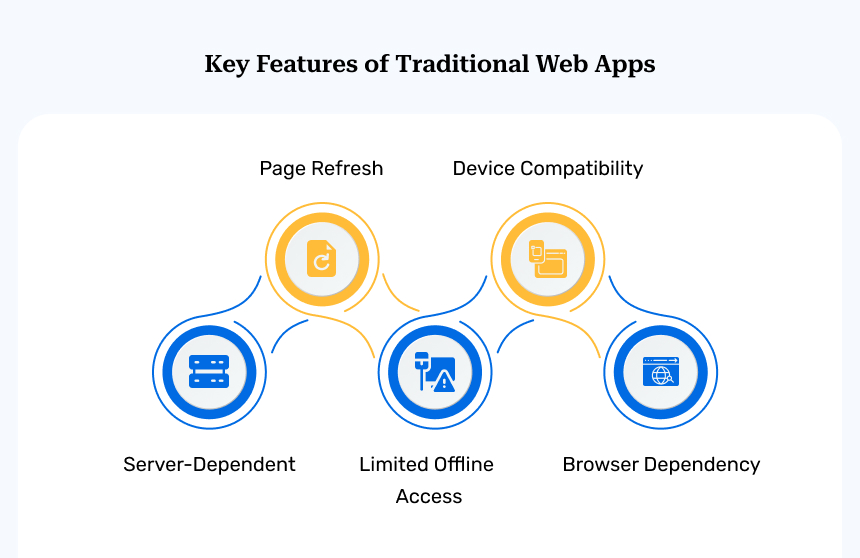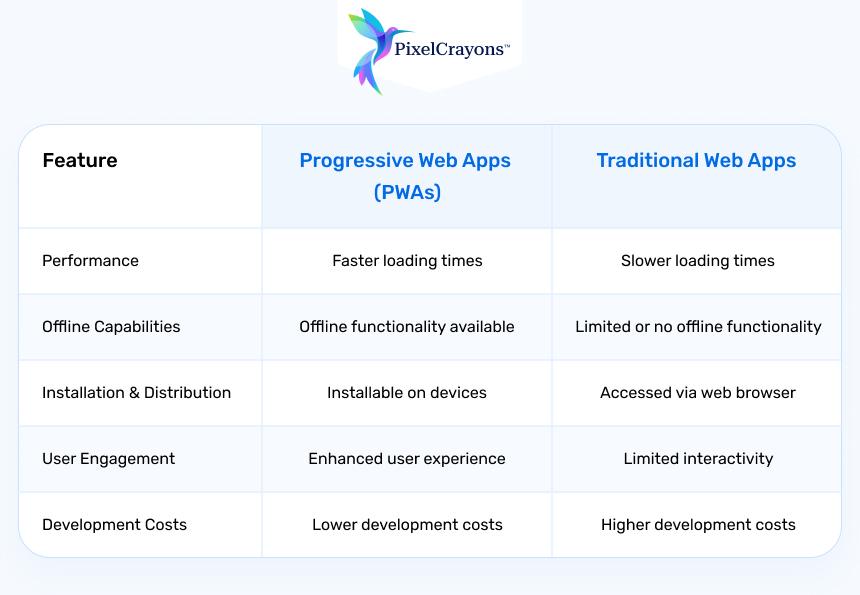Recent research from Emergen Research suggests that the worldwide PWA market was valued at $1.13 billion and is predicted to reach $10.44 billion by 2027, growing at 31.9% annually.
This statistic underscores the growing significance of Progressive Web Apps (PWAs) in the digital landscape.
As businesses strive to boost user experience and engagement, understanding the differences between PWAs and traditional web apps becomes crucial.
PWAs offer faster load times, offline capabilities, and seamless user experiences, making them a preferred choice for many businesses. This blog delves into the comparative analysis of PWA vs traditional web apps, exploring their features, benefits, and strategic implications for businesses.
Whether you’re a developer evaluating technology options or an entrepreneur aiming to stay ahead in the competitive market, this blog will provide valuable insights to inform your decision-making process.
Understanding Progressive Web Apps (PWAs)
PWAs, or progressive web apps, are web apps that use contemporary web technologies to offer experiences similar to apps right within web browsers.
PWAs combine the best of mobile and web app experiences.
They offer features like push notifications, offline functionality, and fast loading speeds typically associated with native mobile apps.
Built with web tech stacks such as HTML, CSS, and JavaScript, PWAs are designed to be responsive and adaptable across various devices and screen sizes.

Their key characteristics include:
Reliable
PWAs load instantly, even in uncertain network conditions, ensuring a seamless user experience.
Fast
They respond promptly to user interactions with smooth animations and scrolling.
Engaging
PWAs feel like natural apps with immersive user experiences.
Secure
PWAs are served via HTTPS to prevent tampering and ensure data integrity.
Responsive
They adapt to various screen sizes and device capabilities.
Importance of PWAs in Enhancing User Experience and Engagement
Let’s say a potential customer visits your website but is met with slow loading times and clunky navigation.
Frustrating, right?
PWAs can change that game entirely.
Check out how PWAs can enhance user experience and engagement:
Enhanced Performance
PWAs offer faster loading times, reducing bounce rates and improving user retention.
Offline Accessibility
Users can access PWAs without an internet connection, ensuring uninterrupted engagement.
Push Notifications
PWAs help you send push notifications to users, keeping them informed and engaged.
Improved Conversion Rates
With enhanced user experience, PWAs lead to increased customer satisfaction and higher conversion rates.
Examples of Successful PWAs in Various Industries
Now, let’s take a look at some real-world examples of successful PWAs in different industries:
Twitter Lite
Twitter made a lighter version of its platform called PWA. It helps users have a fast and good time, even if the network is slow.
Starbucks
Starbucks has a PWA, too. It lets customers order their favorite drinks and pay right from their phone browsers, making shopping easy and smooth for everyone.
Flipkart
Flipkart’s Progressive Web App gives you a shopping experience like an app. It loads quickly and sends you notifications, making shopping fun and helping to sell more items.
Exploring Traditional Web Apps
Traditional web apps are like digital storefronts accessed through web browsers, offering various services and functionalities.
They function primarily on server-side processing and require users to navigate different pages for updates or actions.

Here are five key features:
Server-Dependent
Traditional web apps rely on servers to process user requests and generate responses, which may result in slower performance.
Page Refresh
Users often experience page refreshes when interacting with traditional web apps, leading to interruptions in the user experience.
Limited Offline Access
Unlike PWAs, traditional web apps have limited or no offline capabilities and require an active internet connection.
Device Compatibility
They may not be optimized for different devices and screen sizes, leading to inconsistent user experiences across platforms.
Browser Dependency
Traditional web apps often depend on specific web browsers, impacting performance and compatibility.
Limitations of Traditional Web Apps Compared to PWAs
While traditional web apps have been around for a while, they come with certain limitations when compared to PWAs:
Speed and Performance
Traditional web apps tend to be slower due to server-side processing and page refreshes, impacting user experience and engagement.
Offline Functionality
Unlike PWAs, traditional web apps lack offline functionality, limiting accessibility in areas with low or no internet connectivity.
Engagement Features
They may lack features like push notifications and home screen installations, hindering user engagement and retention.
Limited Interactivity
Traditional web apps may offer less interactivity than PWAs, limiting dynamic content updates and real-time interactions.
Scalability Challenges
Scaling traditional web apps can be challenging, especially with increasing user demands and evolving technology requirements.
Scenarios Where Traditional Web Apps Are Still Preferable
Despite their limitations, traditional web apps still have their place in specific scenarios:
Informational Websites
Websites primarily focused on providing static information, such as blogs or news portals, can function effectively as traditional web apps.
Internal Business Tools
Traditional web apps may offer simplicity and familiarity for internal business tools or applications in a controlled environment.
Legacy Systems Integration
Traditional web apps remain a viable option in cases where integration with legacy systems is necessary or when modernization is not feasible.
Comparative Analysis – PWA vs Traditional Web Apps

Understanding the differences is crucial when choosing between Progressive Web Apps (PWAs) and traditional web apps for your digital marketing strategy.
Let’s compare these two options across critical parameters to help you make an informed decision:
Performance & Speed
- PWAs: PWAs are well-known for their fast loading times and smooth performance, thanks to features like service workers and caching.
- Traditional Web Apps: Traditional web apps may experience slower performance due to their reliance on server-side processing for rendering content.
Offline Capabilities
- PWAs: PWAs shine in offline capabilities, allowing users to access content and perform tasks without an internet connection.
- Traditional Web Apps: Traditional web apps typically require an active internet connection, limiting offline functionality.
Installation & Distribution
- PWAs: PWAs offer seamless installation through browser prompts, allowing users to add them to their home screens without visiting an app store.
- Traditional Web Apps: Traditional web apps lack native installation options and must be accessed through a web browser.
User Engagement and Retention
- PWAs: PWAs enhance user engagement with features like push notifications, background sync, and home screen installations, improving retention rates.
- Traditional Web Apps: Traditional web apps may struggle to engage users with limited features, potentially impacting retention over time.
Development & Maintenance Costs
- PWAs: While PWAs may require higher initial development costs due to advanced features, they often offer lower long-term maintenance costs than native apps.
- Traditional Web Apps: Traditional web apps typically have lower initial development costs but may incur higher maintenance costs, especially during scaling or updates.
Considerations for Enterprises
When making technology decisions for your enterprise, choosing between PWA vs traditional web apps requires careful consideration.
Factors to Consider
Here are some factors to remember:
User Experience
Evaluate how each option enhances user experience and engagement. PWAs often offer faster load times and offline access, while traditional web apps may lack these features.
Scalability
To accommodate growing user bases and evolving business needs, consider the scalability of PWAs and traditional web apps. PWAs are known for their adaptability across devices and screen sizes.
Development Costs
Compare each option’s upfront development costs and ongoing maintenance expenses. While PWAs may require more initial investment, they often lower long-term maintenance costs.
Integration
Assess how well each solution integrates with the enterprise’s existing systems, tools, and infrastructure. Compatibility and seamless data flow are essential for smooth operations.
Security
Prioritize each option’s security features and protocols to safeguard sensitive enterprise data and protect against cyber threats. Consider factors like encryption, authentication, and compliance standards.
Strategic Implications
Choosing between PWAs and traditional web apps goes beyond technical considerations; it has strategic implications for enterprise-level technology decisions.
Competitive Advantage
Use innovative technologies like PWAs to gain a competitive business edge in the digital marketplace.
PWAs can provide superior user experiences, driving customer acquisition and retention.
Customer Experience
Recognize the pivotal role of user experience in shaping customer perceptions and brand loyalty.
Opt for the option that aligns with your enterprise’s commitment to delivering exceptional customer experiences.
Future Readiness
Anticipate future trends and advancements in digital marketing technology.
Select the option that positions your enterprise for long-term success and adaptability in a rapidly evolving landscape.
Future Landscape & Adoption Trends
Looking ahead, the future landscape of web applications is undoubtedly influenced by the rise of PWAs.
Big companies like Google say PWAs are the future of web apps. This means more industries will start using them.
PWAs can help businesses in many ways. They are flexible and can grow easily. This means businesses can make better apps and save money on upkeep.
Some new trends in PWAs will change how we use the internet:
- Augmented Reality (AR) Integration
- Voice Interfaces and Natural Language Processing
- Machine Learning and Personalization
- Offline Capabilities and Syncing
- Offline Forms and Data Management
To Conclude
As we look ahead to the future web development landscape, the debate between PWA vs traditional web apps continues.
PWAs improve websites and can work without the internet, but Traditional Web Apps are still useful sometimes. It’s important to know your business needs and goals.
Using the right technology, businesses can improve their online presence and interact with users more effectively. Whether you choose PWAs or Traditional Web Apps, getting custom website development services is important to staying competitive online.


